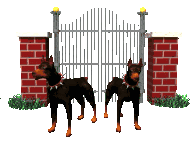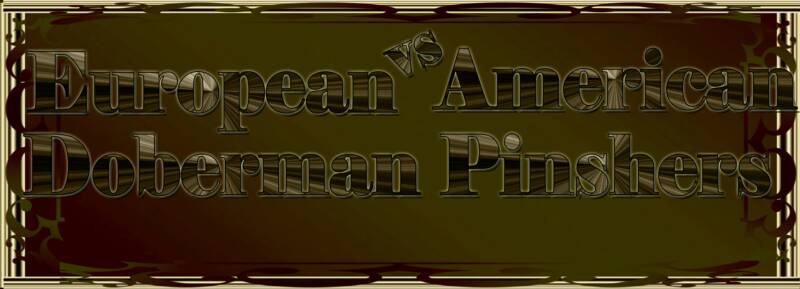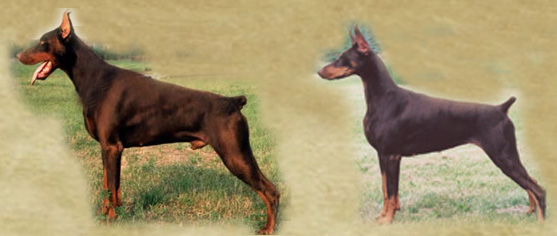Import vs. American
Import (European) Doberman Pinschers
Focus on Workability
The Doberman Pinscher was originally produced in Germany as a personal protector for individuals and families, and for police and military work. Throughout Europe, this is still the case. Here the Doberman, or Dobermann as it is spelled, is viewed as a dog primarily for protection work and is breed with the intention of maintaining the traits need in a protection dog, usually termed "workability".
In fact, before a Doberman's offspring can be registered in Europe, one of its parents must hold a Schutzhund title. Schutzhund is German for 'protection dog' and refers to a system for testing dogs of working breeds for workability. It has also grown into a popular sport in Europe and somewhat throughout the United Stated, although the American Kennel Club (AKC) does not allow its affiliates to sanction Schutzhund trials.
Under the common European and German philosophy, the Doberman is a compact dog untouchable by anyone but its owner, handler, or family. He must be strictly obedient under all circumstance and is expected to meet threats with all-out aggression.
It is understood and accepted that the Doberman Pinscher is a real physical danger to anyone approaching the Doberman's home or family in a threatening way Understand, the European Doberman, like all healthy and properly socialized Dobermans, is not vicious. A mindless attack dog is not the goal of Schutzhund - the opposite in fact. A mindless attacker is useless in protection work.
The ideal protection Doberman is clam and friendly- until a threat is revealed. Then he will emit loud warning barks and keep himself between his handler and the threat, not pulling or leaving his handler. Only when the threat attacks, or when he is commanded, will the ideal protection Doberman attack. This is the goal of preserving the working traits and a priority in European and German Doberman Pinscher breeding.
AMERICAN DOBERMAN PINSCHER
Focus on pets and the Show Ring
The main difference between American and European Doberman breeding is human social attitude. In the United States, where litigation involving dog bites is as rampant as irresponsible dog owners, the common consensus seems to be that only 'vicious' dogs bite.
This was no more evident than when the United Doberman Club was formed in the US after the AKC decision to disallow Schutzhund due to the protection phase which involves bite work. The United Doberman Club currently holds Schutzhund trials under the auspices of the American Working Dog Federation.
Also making this misguided social view starkly evident are the Breed Specific laws that have been proposed, and many passed, in an effort to reduce dog bites. Advocates of Breed Specific legislation ignore the real cause of dog bite, irresponsible people, and place the blame not only on the dog, but on specific breeds of dog. This is unfair but more importantly, it is ineffective. Breed Specific laws will not and do not fix the problem.
Regardless of popular attitude, many Doberman owners and breeders in the United States still work to maintain the working traits in the Doberman and participate in Schutzhund.
Partially due to the popular altitude and partially due simply to Americas love of different aspects of the dog, the goals of most Doberman breeders in America are for the production of pet or companion dogs, and show dogs.
One of the reasons the Doberman is so popular in the US is that it is such a loving, gentle, and devoted companion dog who fits exceptionally well into the busy American family.
Quality breeders focused on producing the Doberman as a companion are most concerned with health and temperament. However, the temperament most companion Doberman breeders look for is a general sure and friendly temperament.
In the US there are no temperament tests required for registering a Doberman litter: certainly not anything approaching the intensity or required human dedication as with Schutzhund trials. This lack of temperamental standardization has allowed irresponsible breeders to register their ill planned litters, which has contributed to the degradation of the Doberman breed. Irresponsible breeders have further degraded the Doberman breed by placing their puppies with who ever offers money. This has placed the Doberman in the hands of irresponsible owners who have neglected the Doberman's needs, such as training and socialization, creating troubled and dangerous Dobermans.
This irresponsible branch of Doberman production in the US is certainly the main cause of the misguided American attitude toward the Doberman. Also contributing are the many movies and video games depicting the Dobermans vicious.
Regardless of temperament standards, quality breeders in the US maintain exceptional standards on their own for the temperament of their breeding Dobermans. Quality breeders are highly discrimination when placing their puppies: they will only place them in homes that have shown their willingness and ability to properly care for a Doberman.
This dedicated type of Doberman breeder, often called master breeder, is the guardian of the Doberman breed. Their breeding is well planned with goals of contribution to and improving the Doberman breed.
These dedicated master breeders have produced some of the healthiest and beautiful Dobermans in the world and have grown a strong branch of quality Doberman lines in the US often including German imports. Dobermans from this branch, in comparison to their European counterparts are gorgeous, the super-models of the Doberman world. They are longer lived, and possess the same distinctive Doberman temperament but slightly sweeter and friendlier: a soft temperament by European standards.
This awesome branch of American Dobermans has taken over the US show ring, no longer referred to as guard or protection dogs but as family companions.
Also producing quality American Dobermans, but contributing less to the Doberman breeder, are breeders focused on show dogs. The problem with these breeders is just that, they are focused on show confirmation- not health and temperament.
The differences between the European and American Doberman Pinscher has caused some people to suggest that the breed be split. However, any guardian of the Doberman breed will fight such a foolish idea. Doing so would drastically reduce the already small quality gene pool and would likely further reduce the American Doberman's working traits.



 | ||||||
